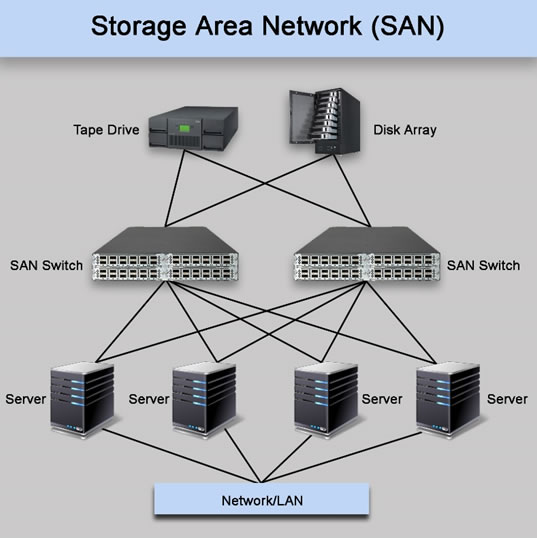Storage Area Network (SAN)

A storage-area network (SAN) is a dedicated high-speed network (or subnetwork) that interconnects and presents shared pools of storage devices to multiple servers.
A SAN moves storage resources off the common user network and reorganizes them into an independent, high-performance network. This allows each server to access shared storage as if it were a drive directly attached to the server. When a host wants to access a storage device on the SAN, it sends out a block-based access request for the storage device.
A storage-area network is typically assembled using three principle components: cabling, host bus adapters (HBAs) and switches. Each switch and storage system on the SAN must be interconnected and the physical interconnections must support bandwidth levels that can adequately handle peak data activities.
Storage-area networks are managed centrally, and Fibre Channel (FC) SANs have the reputation of being expensive, complex and difficult to manage. The emergence of iSCSI has reduced these challenges by encapsulating SCSI commands into IP packets for transmission over an Ethernet connection, rather than an FC connection. Instead of learning, building and managing two networks — an Ethernet local-area network (LAN) for user communication and an FC SAN for storage — an organization can now use its existing knowledge and infrastructure for both LANs and SANs.
Virtual SAN
A virtual storage-area network (VSAN) is a software-defined storage offering that is implemented on top of a hypervisor such as VMware ESXi or Microsoft Hyper-V. Virtual SANs yield a number of benefits such as ease of management and scalability. For the most part, VSANs are hardware-agnostic. As long as the storage hardware is recognized and supported by the hypervisor, the hardware can be used by the VSAN (although each vendor has its own requirements).
Unified SAN
Unified SAN is based around the concept of unified storage, which exposes file storage and block storage through a single device (usually a modified NAS appliance).
Converged SAN
Storage-area networks are normally kept separate from Ethernet networks. A converged SAN uses a common network infrastructure for network and SAN traffic to eliminate redundant infrastructure, and to reduce cost and complexity.
SANs often make use of FC, while data networks are usually based on Ethernet. Converged SANs adopt Fibre Channel over Ethernet (FCoE), which encapsulates FC payloads into Ethernet frames. Converged SANs are almost always based on 10 Gigabit Ethernet, and multiple network ports are sometimes bonded together to increase throughput.
SAN pros and cons
The main benefit to using a SAN is that raw storage is treated as a pool of resources that can be centrally managed and allocated on an as-needed basis. SANs are also highly scalable because additional capacity can be added as required.
The main disadvantages to SANs are cost and complexity. SAN hardware tends to be expensive, and building and managing a SAN requires a specialized skill set.
SAN vs. NAS
The terms SAN and NAS are sometimes confused with one another because the acronyms are so similar. NAS consists of a storage appliance that is plugged directly into a network switch. Although there are exceptions, NAS appliances are often used as file servers.
A SAN is far more complex and costly than NAS. A SAN consists of dedicated cabling (usually FC, but Ethernet can be used in iSCSI or FCoE SANs), dedicated switches and storage hardware. SANs are highly scalable and allow storage to be exposed as LUNs. In contrast, NAS storage usually exposes storage as a file system, although some NAS appliances support block storage.